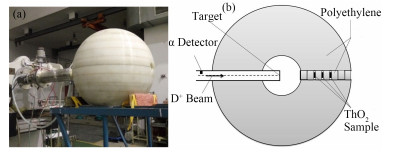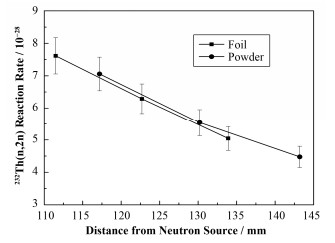2. 四川大学 物理科学与技术学院 核工程与核技术系 成都 610064;
3. 清华大学 工程物理系 北京 100084
2. Department of Nuclear Engineering and Technology, College of Physical Sciences and Technology, Sichuan University, Chengdu 610064, China;
3. Department of Engineering Physics, Tsinghua University, Beijing 100084, China
目前,加速器驱动次临界能源系统(Accelerator Driven Subcritical System, ADS)、聚变裂变混合能源堆(Fusion Fission Hybrid Energy Reactor, FFHER)、和钍基熔盐堆(Thorium Based Molten Salt Reactor, TMSR)等[1-2]新型反应堆正在被广泛研究。而钍的储备丰富,且233U较239Pu具有更好安全性能。因此,以钍为基础的新型反应堆成为一种较有吸引力的选择[3]。在聚变中子能区,232Th(n, 2n)231Th反应主导中子增殖,且对中子的输运过程有重要影响,因此,其数据可靠性对相关反应堆的物理设计至关重要。
从1961年至今,发表了很多232Th(n, 2n)231Th反应截面的测量工作[4-12],其中:Prestwood等[4]测量了12.13~14.93 MeV的12个能点的数据;Karamanis等[6]测量了7~12 MeV的14个能点;Crasta等[7-8, 10-11]和Lan等[12]主要测量了14 MeV左右的截面数据,测量结果在中子能区13~15 MeV的差异很大,甚至在标准核数据库中(ENDF/B-Ⅶ.0[13]、NDF/B-Ⅶ.1[14]、JENDL4.0[15]),其差异超过20%。另一方面基于反应堆应用的中子积分学宏观校验实验却开展的很少。1989年,Zagryadskii等[16]采用活化法测量了钍球壳中的232Th(n, 2n)231Th反应率,实验误差为4.3%,但是其实验结果比在ENDF/B-IV数据库下的模拟结果大了18%;2011年,Adam等[17]给出了在石墨装置中不同位置的232Th(n, 2n)231Th反应率值,其E/C(实验/模拟)值达到2.33和4.7;2015年,Feng等[18]在复杂钍铀交替系统中测量了232Th(n, 2n)231Th反应率,三套实验装置下的实验反应率均和JENDL4.0数据库下的模拟反应率符合较好;由于其装置材料的复杂性,2017年,Liu等[19]开展了在氧化钍钢桶装置下的同类型实验,同样,实验结果和在JENDL4.0下的模拟结果在实验不确定度内符合较好。由于聚乙烯材料的截面数据都为标准截面,因此直接在基准装置中开展232Th(n, 2n)231Th反应率中子学积分实验是重要的,可以直接校验其截面数据的准确性,为相关反应堆设计提供数据支持。本文基于聚乙烯球壳装置,在DT中子下开展了232Th(n, 2n)231Th反应率测量的中子积分学实验,并将实验结果与不同数据库下的模拟结果进行了对比分析。
1 实验 1.1 实验原理232Th(n, 2n)231Th反应率值采用活化法测量,如以下衰变链所示。中子辐照232Th样品,生成231Th,进而发生β-衰变,同时发射出分支比为6.6%、能量为84.2 keV的γ射线[20]。
| $ {}^{232}\text{Th}\xrightarrow{\text{n}, 2\text{n}}{}^{231}\text{Th}\xrightarrow{{{\text{ }\!\!\beta\!\!\text{ }}^{-}}\text{decay}}{}^{231}\text{Pa} $ |
通过测量此反应得到生成的231Th量,进而得到反应率值,如式(1)、(2)所示。
| $ R = \frac{{nK}}{{\overline \phi NFA\varepsilon \eta }} $ | (1) |
| $ F = \frac{{(1-{{\rm{e}}^{-\lambda T}}){{\rm{e}}^{-\lambda \tau }}1 - {{\rm{e}}^{ - \lambda t}}}}{\lambda } $ | (2) |
式中:R为232Th(n, 2n)231Th反应率;n为经过死时间修正的84.2 keV γ峰计数;K为中子注量波动修正因子;
实验在中国工程物理研究院核物理与化学研究所的PD-300加速器上开展。入射D离子束流强度为200 μA,能量为120 keV,氚靶底衬直径为0.6cm,氚用钛膜吸附,其厚度为3.0 mg∙cm-2。实验中,金硅面α探测器安装于距靶63.2 cm,且与入射D离子成178°的位置,以监测中子产额,以及每隔10 s的注量实时波动情况[21]。照射钍粉末样品时,照射时长为24585s,中子平均产额为9.68×109 s-1;照射钍片样品时,照射时长为22510 s,中子平均产额为6.34×109 s-1。
1.2.2 聚乙烯球壳装置及样品实验装置如图 1(a)、(b)所示,聚乙烯球壳内外半径分别为8 mm、230 mm,密度0.95 g∙cm-3,直径方向开有直径为22 mm的孔道。靶穿过球壳孔道,三组实验钍样品放置于孔道内,样品中心线与入射D离子成0°,每组样品根据距源由近到远编号为1、2、3。钍样品纯度为99.95%,存在形式为氧化钍。氧化钍粉末样品质量约为0.4 g,压紧后装在内外直径为18 mm和19 mm、高度为0.5 mm的聚乙烯盒子中。氧化钍片状样品质量约为4.1 g,直径30mm,厚度约为1 mm。

|
图 1 实验装置 (a)实物图,(b)示意图 Figure 1 Experimental setup (a) Physical picture, (b) Schematic diagram |
照射钍样品的γ放射性用HPGe高纯锗探测谱仪测量,包括美国ORTEC公司生产的型号为GEM60P的探测器,及GAMMAVISION峰信息读出系统。探头有效体积250 cm3,谱仪相对探测效率为60%,在1.33 keV处的能量分别率为1.87 keV。
1.3 实验数据分析与结果 1.3.1 γ射线测量所有ThO2样品的γ射线测量均在HPGe高纯锗探测谱仪完成,且在照射之前进行了本底测量,在84.2 keV处观察到干扰峰,如图 2(a)所示。照射之后的样品γ谱如图 2(b)所示,除去本底干扰的γ谱如图 2(c)所示,图 2为第三组钍粉的数据,由于数据相似性,这里不一一给出,样品计数率归一到g-1∙s-1。

|
图 2 3号钍粉末样品的γ谱图 (a)本底测量γ谱,(b)照射测量γ谱,(c)除去本底的γ谱 Figure 2 The γ spectra of the No.3 thorium powder sample (a) Background spectra, (b) Irradiated spectra, (c) Net spectra |
为了标定所使用的HPGe探测谱仪,利用一系列点源对探测器做效率刻度。样品测量时,其中心在探测器轴线上,由于所测样品为面源,因此测量时,在测量位置的径向平面分别刻度距中心不同径向位置(0 mm、5 mm、10 mm、15 mm)的探测效率,然后对不同能点对应位置的探测效率进行二项拟合,再做面源积分,得到对应半径面源的探测效率[22]。钍粉末及钍片在84.2 keV处的探测效率分别为11.76%、11.95%。
钍样品具有一定的厚度,γ射线在其中会有衰减效应,其能量越低,衰减效应越强。因此在测量时,并不是所有的γ射线均可从样品内发射出来,且γ射线在样品内被吸收后的出射角度会发生变化,因此同时会对探测效率造成影响。为了做此修正,利用蒙特卡罗对所使用的探测器准确建模,精确记录测量时样品的位置以及质量和厚度信息,计算其自吸收修正因子。先计算没有样品时,与样品半径一样的面源探测效率η2,再计算放置样品时的探测效率η1,则自吸收校正因子A为:
| $ A = \frac{{{\eta ^1}}}{{{\eta ^2}}} $ | (3) |
正如§1.2.1中提到的,实验过程中,用金硅面探测器对中子注量做监测,监测周期为10 s。注量波动修正因子为K,如式(4)所示,其中wi为第i个10 s的间隔,Nα(i)为第i个10 s内探测到的α粒子数[23]。钍粉末和钍片实验中K值分别为1.00363、1.01687。
| $ K = \frac{{\bar \Phi }}{\Phi } = \frac{{\sum {{N_{\rm{ \mathit{ α} }}}(i) \cdot (1-{{\rm{e}}^{-\lambda T}})} }}{{\lambda T\sum\limits_i {{N_{\rm{ \mathit{ α} }}}(i) \cdot {{\rm{e}}^{-\lambda (T - {w_i})}}} }} $ | (4) |
根据式(1)得到232Th(n, 2n)231Th反应率,钍粉末及钍片样品的实验结果如图 3所示。可以看到不同的样品形态在宏观实验装置中的232Th(n, 2n)反应率趋势一致。随着距源距离增加,样品处的中子通量减小,导致反应率减小。

|
图 3 232Th(n, 2n)231Th反应率实验值 Figure 3 The experimental reaction rate of 232Th(n, 2n)231Th |
两次实验中,引起实验误差的因素有中子监测系统、探测效率刻度、样品自吸收修正因子、样品称重、γ射线分支比及统计计数,由于各项误差互不相关,且计算公式为一次积商形式,因此计算总的不确定度可简化为对各项不确定度的平方和求根。具体分析如表 1所示,实验总的不确定度为7.33%~7.36%。
| 表 1 232Th(n, 2n)231Th反应率的实验不确定度分析 Table 1 Uncertainty analysis for experimental reaction rate of 232Th(n, 2n)231Th |
采用蒙特卡罗的方法用MCNP[24]软件计算232Th(n, 2n)231Th的反应率值,分别计算了在数据库ENDF/B-Ⅶ.1、ENDF/B-Ⅶ.0、JENDL-4.0下的结果,列于表 2。计算模型包括实验大厅、氧化钍样品、聚乙烯球壳及中子靶室,并且利用Drosg2000[25]计算了中子源的角分布。在计算时,考虑了输运介质对计算结果的影响。结果表明:输运介质采用不同的数据库时,对反应率结果的影响小于1%。计算中采用了F4卡以及FMn卡,运行了4亿个中子历史,1σ处的统计误差小于1%。
| 表 2 钍粉末和钍片232Th(n, 2n)231Th反应率的蒙特卡罗计算结果 Table 2 232Th(n, 2n)231Th reaction rates for thorium powder given by Monte Carlo calculation |
将232Th(n, 2n)231Th的计算和实验结果的比值作图,如图 4所示。对于钍片来说,实验反应率比在ENDF/B-Ⅶ.1、ENDF/B-Ⅶ.0中的模拟反应率大9.45%、9.91%,而比JENDL-4.0的模拟结果小9.59%。对钍粉而言,实验反应率比在ENDF/B- Ⅶ.1、ENDF/B-Ⅶ.0中的模拟反应率大9.55%、10.02%,而比JENDL-4.0的模拟结果小8.48%。综合两次实验结果,在聚乙烯球壳装置下,JENDL-4.0的模拟结果和实验符合更好。

|
图 4 钍片(a)和钍粉末(b)的C/E值 Figure 4 C/E value for thorium foil (a) and thorium powder (b) |
本文采用活化及离线测量技术得到了在聚乙烯球壳下不同钍样品形态的232Th(n, 2n)反应率值,实验不确定度为7.33%~7.36%。同时,利用蒙特卡罗做了对应的模拟计算。结果表明:基于当前的宏观装置,实验结果与JENDL-4.0的模拟结果符合较好。该结果可以丰富中子积分学的实验数据库,并且为钍相关的反应堆物理设计提供数据参考及支持。
致谢 感谢PD-300加速器运行期间加速器团队的辛苦劳作。| [1] |
郭晨, 冀锐敏, 陈金根, 等. 钍基液态燃料熔盐实验堆氙毒分析[J]. 核技术, 2017, 40(4): 040602. GUO Chen, JI Ruimin, CHEN Jingen, et al. Xenon analysis of thorium molten salt experiment reactor-liquid fuel[J]. Nuclear Techniques, 2017, 40(4): 040602. DOI:10.11889/j.0253-3219.2017.hjs.40.040602 |
| [2] |
李光超, 邹杨, 余呈刚, 等. 基于熔盐快堆的模型优化与Th-U增殖性能研究[J]. 核技术, 2017, 40(2): 020603. LI Guangchao, ZOU Yang, YU Chenggang, et al. Model optimization and analysis of Th-U breeding based on MSFR[J]. Nuclear Techniques, 2017, 40(2): 020603. DOI:10.11889/j.0253-3219.2017.hjs.40.020603 |
| [3] |
Wols F J, Kloosterman J L, Lathouwers D, et al. Conceptual design of a passively safe thorium breeder pebble bed reactor[J]. Annals of Nuclear Energy, 2015, 75: 542-558. DOI:10.1016/j.anucene.2014.09.012 |
| [4] |
Prestwood R J, Bayhurst B P. Excitation functions of several nuclei from 12.0 to 19.8 MeV[J]. Physical Review, 1961, 121(5): 1438-1441. DOI:10.1103/PhysRev.121.1438 |
| [5] |
Butler J P, Santry D C. 232Th(n, 2n)231Th cross section from threshold to 20.4 MeV[J]. Canadian Journal of Chemistry, 1961, 39(3): 689-696. DOI:10.1139/v61-083 |
| [6] |
Karamanis D, Andriamonje S, Assimakopoulos P A, et al. Neutron cross-section measurements in the Th-U cycle by the activation method[J]. Nuclear Instruments & Methods in Physics Research, 2003, 505(1-2): 381-384. DOI:10.1016/S0168-9002(03)01102-1 |
| [7] |
Crasta R, Naik H, Suryanarayana S V, et al. Measurement of the 232Th(n, γ)233Th and 232Th(n, 2n)231Th reaction cross-sections at neutron energies of 8.04±0.30 and 11.90±0.35 MeV[J]. Annals of Nuclear Energy, 2012, 47(47): 160-165. DOI:10.1016/j.anucene.2012.02.010 |
| [8] |
Naik H, Prajapati P M, Surayanarayana S V, et al. Measurement of the neutron capture cross-section of 232Th using the neutron activation technique[J]. European Physical Journal A, 2011, 47(4): 51. DOI:10.1140/epja/i2011-11051-2 |
| [9] |
Reyhancan I A. Measurements and model calculations of activation cross sections for 232Th(n, 2n)231Th reaction between 13.57 and 14.83 MeV neutrons[J]. Annals of Nuclear Energy, 2011, 38(11): 2359-2362. DOI:10.1016/j.anucene.2011.07.032 |
| [10] |
Prajapati P M, Naik H, Suryanarayana S V, et al. Measurement of the neutron capture cross-sections of 232Th at 5.9 MeV and 15.5 MeV[J]. European Physical Journal A, 2012, 48(3): 35. DOI:10.1140/epja/i2012-12035-4 |
| [11] |
Naik H, Surayanarayana S V, Bishnoi S, et al. Neutron induced reaction cross-section of 232Th and 238U at the neutron energies of 2.45 and 14.8 MeV[J]. Journal of Radioanalytical & Nuclear Chemistry, 2015, 303(3): 2497-2504. DOI:10.1007/s10967-014-3812-8 |
| [12] |
Lan C L, Xie B L, Zhang K, et al. Measurement of 232Th(n, 2n)231Th reaction cross-sections at neutron energies of 14.1 MeV and 14.8 MeV using neutron activation method[J]. Nuclear Science and Techniques, 2015, 26(6): 060501. DOI:10.13538/j.1001-8042/nst.26.060501 |
| [13] |
Chadwick M B, Obložinský P, Herman M, et al. ENDF/B-Ⅶ.0:next generation evaluated nuclear data library for nuclear science and technology[J]. Office of Scientific & Technical Information Technical Reports, 2006, 107(12): 2931-3060. DOI:10.1016/j.nds.2006.11.001 |
| [14] |
Chadwick M B, Herman M, Obložinský P, et al. ENDF/B-Ⅶ.1 nuclear data for science and technology:cross sections, covariances, fission product yields and decay data[J]. Nuclear Data Sheets, 2011, 112(12): 2887-2996. DOI:10.1016/j.nds.2011.11.002 |
| [15] |
Keiichi S, Osamu I, Tsuneo N, et al. JENDL-4.0:a new library for nuclear science and engineering[J]. Journal of Nuclear Science & Technology, 2011, 48(1): 1-30. DOI:10.1080/18811248.2011.9711675 |
| [16] |
Zagryadskii V A, Markovskii D V, Novikov V M, et al. Calculated neutron transport verifications by integral 14 MeV-neutron source experiments with multiplying assemblies[J]. Fusion Engineering & Design, 1989, 9(3): 347-352. DOI:10.1016/S0920-3796(89)80056-0 |
| [17] |
Adam J, Katovsky K, Majerle M, et al. A study of nuclear transmutation of Th and natU with neutrons produced in a Pb target and U blanket irradiated by 1.6 GeV deuterons[J]. European Physical Journal A, 2010, 43(2): 159-173. DOI:10.1140/epja/i2010-10909-y |
| [18] |
Feng S, Yang Y W, Lu X X, et al. An integral experiment on thorium oxide/depleted uranium cylinders with D-T neutrons for 232Th(n, 2n) reaction[J]. Annals of Nuclear Energy, 2015, 81: 281-286. DOI:10.1016/j.anucene.2015.03.002 |
| [19] |
Liu Z J, Yang C, Yang Y, et al. Measurement and analysis of 232Th(n, 2n)231Th reaction rate in the thorium oxide cylinder with a D-T neutron source[J]. Annals of Nuclear Energy, 2018, 111: 660-665. DOI:10.1016/j.anucene.2017.06.041 |
| [20] |
Pearlstein. National nuclear data center[J]. Betascript Publishing, 1977, 22(3): 23-26. |
| [21] |
刘荣, 林理彬. 用大角度伴随粒子法测量聚变中子产额及其校对实验[J]. 核电子学与探测技术, 1999, 19(6): 429-432. LIU Rong, LIN Libin. Measurement and check of fusion neutron yield with the method of associated particles at a large angle[J]. Nuclear Electronics & Detection Technology, 1999, 19(6): 429-432. |
| [22] |
羊奕伟, 刘荣, 蒋励, 等. 一维贫铀/聚乙烯交替系统中D-T中子诱发的232Th(n, γ)反应率的测定与分析[J]. 物理学报, 2014, 63(16): 162801. YANG Yiwei, LIU Rong, JIANG Li, et al. Determination of 232Th(n, γ) reaction rate induced by D-T neutrons in one-dimensional alternate depleted uranium/polyethylene shells[J]. Acta Physica Sinica, 2014, 63(16): 162801. DOI:10.7498/aps.63.162801 |
| [23] |
冯松, 刘荣, 鹿心鑫, 等. 离线测量钍裂变反应率方法[J]. 物理学报, 2014, 63(16): 162501. FENG Song, LIU Rong, LU Xinxin, et al. Determination of thorium fission rate by off-line method[J]. Acta Physica Sinica, 2014, 63(16): 162501. DOI:10.7498/aps.63.162501 |
| [24] |
Briesmeister J F. MCNP-a general Monte Carlo N-particle transport code[F]. Version 4B. LA-12625-M. New Mexico: Los Alamos National Laboratory, 1997.
|
| [25] |
Drosg M. DROSG-2000, PC database for 56 neutron source reactions, documented in the IAEA report IAEA-NDS-87 Rev. 5[R]. PC diskettes received/downloaded from the IAEA Nuclear Data Section, 2000.
|


